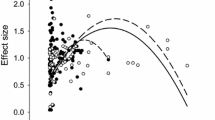Abstract
Disturbance has many effects on ecological communities, and it is often suggested that disturbance can affect species diversity by altering competitive outcomes. However, disturbance regimes have many distinct aspects that may act, and interact, to influence species diversity. While there are many theoretical models of disturbance-prone communities, few have specifically documented how interactions between different aspects of a disturbance regime change competitive outcomes. Here, we present a model of two plant species subject to disturbance which we then use to examine species coexistence over varying levels of two aspects of disturbance: frequency, and spatial extent (i.e., area disturbed). We show that the competitive outcome is affected differently by changes in each aspect and that the effect of disturbance frequency on species coexistence depends strongly on the spatial extent of the disturbance, and vice versa. We classify the nature of these interactions between disturbance frequency and extent on the basis of the shape of the resulting coexistence regions in a frequency–extent parameter plane. Our results illustrate that different types of interaction can result from differences in life-history traits that control species-specific sensitivity to frequency and extent of disturbance. Thus, our analysis shows that the various aspects of disturbance must be carefully considered in concert with the life-history traits of the community members in order to assess the consequences of disturbance.




Similar content being viewed by others
References
Bolker, B. and Pacala, S. 1999 Spatial moment equations for plant competition: understanding spatial strategies and the advantages of short dispersal. Am Nat 153:575–602
Buckling A, Kassen R, Bell G, Rainey PB (2000) Disturbance and diversity in experimental microcosms. Nature 408:961–964
Calcagno V, Mouquet N, Jarne P, David P (2006) Coexistence in a metacommunity: the competition–colonization trade-off is not dead. Ecol Lett 9:897–907
Chesson P (2000) General theory of competitive coexistence in spatially-varying environments. Theor Popul Biol 58:211–237
Chesson P, Huntly N (1997) The roles of harsh and fluctuating conditions in the dynamics of ecological communities. Am Nat 150:519–553
Connell J (1978) Diversity in tropical rain forests and coral reefs. Science 199:1302
dos Santos FS, Johst K, Huth A, Grimm V (2010) Interacting effects of habitat destruction and changing disturbance rates on biodiversity: who is going to survive? Ecol Model 221:2776–2783
Elkin CM, Possingham H (2008) The role of landscape-dependent disturbance and dispersal in metapopulation persistence. Am Nat 172:563–575
Grime J (1977) Evidence for the existence of three primary strategies in plants and its relevance to ecological and evolutionary theory. Am Nat 111:1169–1194
Haddad NM, Holyoak M, Mata TM, Davies KF, Melbourne BA, Preston K (2008) Species’ traits predict the effects of disturbance and productivity on diversity. Ecol Lett 11:348–356
Higgins SI, Cain ML (2002) Spatially realistic plant metapopulation models and the competition–colonization trade-off. J Ecol 90:616–626
Mackey RL, Currie DJ (2001) The diversity–disturbance relationship: is it generally strong and peaked?. Ecology 82:3479–3492
McCabe DJ, Gotelli NJ (2000) Effects of disturbance frequency, intensity, and area on assemblages of stream macroinvertebrates. Oecologia 124:270–279
Miller T (1982) Community diversity and interactions between the size and frequency of disturbance. Am Nat 120:533–536
Miller AD, Roxburgh SH, Shea K (2011) How frequency and intensity shape diversity–disturbance relationships. Proc Natl Acad Sci USA 108:5643–5648
Petraitis P, Latham R, Niesenbaum R (1989) The maintenance of species diversity by disturbance. Quart Rev Biol 64:393–418
Roxburgh S, Shea K, Wilson J (2004) The intermediate disturbance hypothesis: patch dynamics and mechanisms of species coexistence. Ecology 85:359–371
Shea K, Roxburgh SH, Rauschert ESJ (2004) Moving from pattern to process: coexistence mechanisms under intermediate disturbance regimes. Ecol Lett 7:491–508
Skarpaas O, Shea K (2007) Dispersal patterns, dispersal mechanisms, and invasion wave speeds for invasive thistles. Am Nat 170:421–430
Sousa W (1984) The role of disturbance in natural communities. Annu Rev Ecol Syst 15:353–391
Svennson J, Lindegarth M, Pavia H (2009) Equal rates of disturbance cause different patters of diversity. Ecology 90:496–505
Tilman D (1994) Competition and biodiversity in spatially structured habitats. Ecology 75:2–16
Violle C, Pu Z, Jiang L (2010) Experimental demonstration of the importance of competition under disturbance. Proc Natl Acad Sci USA 107:12925–12929
Yu DW, Wilson HB (2001) The competition–colonization trade-off is dead; long live the competition–colonization trade-off. Am Nat 158:49–63
Acknowledgments
We would like to thank Stephen Roxburgh for inspiration, as well as comments on the manuscript. This work was supported by NSF grant DEB-0815373 and an NSF REU to K.S.
Author information
Authors and Affiliations
Corresponding author
About this article
Cite this article
Miller, A., Reilly, D., Bauman, S. et al. Interactions between frequency and size of disturbance affect competitive outcomes. Ecol Res 27, 783–791 (2012). https://doi.org/10.1007/s11284-012-0954-4
Received:
Accepted:
Published:
Issue Date:
DOI: https://doi.org/10.1007/s11284-012-0954-4




